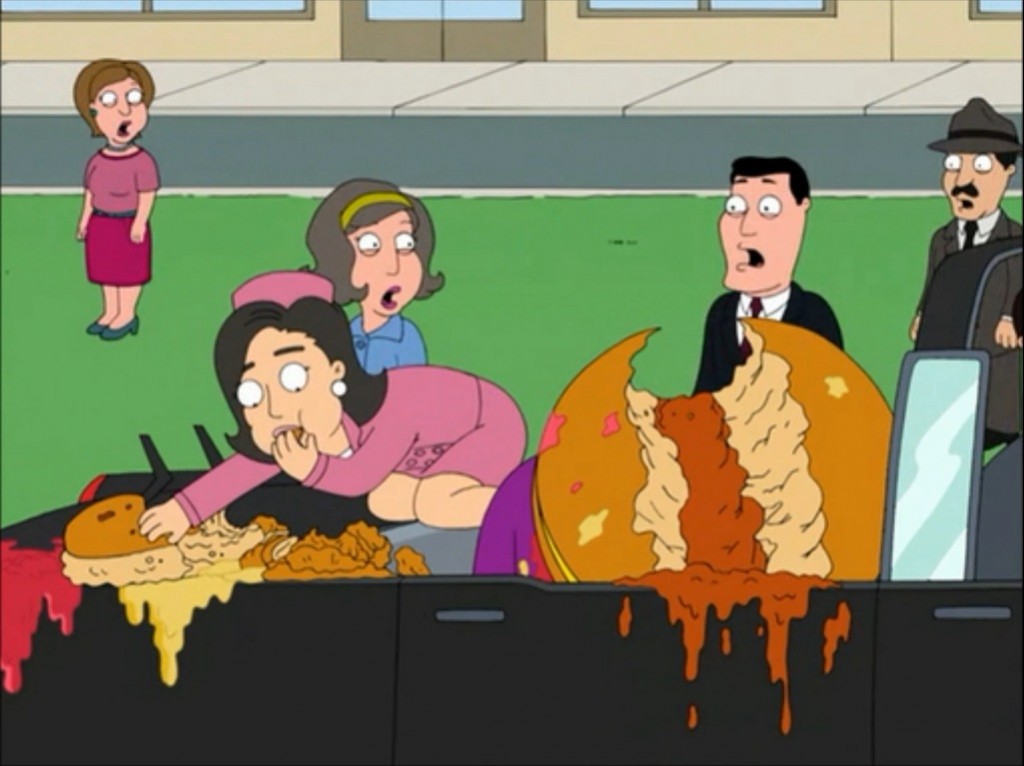Mediating the Past: Sacred History and Sacrilegious Television Comedy
**This post is part of our series, Mediating the Past, which focuses on how history is produced, constructed, distributed, branded and received through various media.
In a 2009 episode, Family Guy joked about a world in which JFK had never been shot. This was not an earnest exploration of historical causality however, but a setup to a gruesome site gag replacing JFK’s assassination with Mayor McCheese’s. To make matters worse, after the parody’s eerily accurate recreation of the event, Jacqueline Kennedy climbs onto the back of the car not to flee, but to eat the McViscera. Of course, offensive humor is Family Guy‘s stock in trade and a spin around the young-skewing dial from FOX to Comedy Central to Adult Swim reveals a host of gags about collective traumas from the assassinations of the 1960s to the catastrophes of 9/11 and Katrina in the 2000s. Even more recent events like the Penn State scandal and the Aurora shootings have comics laughingly asking, “Too soon?”
Joking on these topics offends because they are sacred moments in popular culture’s understanding of its own history. Reportage defines these events using a combination of extreme seriousness and emotion, marking them as sacred in the senses of their importance, uniqueness, and as common touchstones for popular memory. Indeed, the two most archetypal “national traumas” remain the Kennedy assassination and 9/11. The cliche stating that everyone recalls where they were when they first heard about either highlights their importance to both individual and national history. The rules governing humor in bad taste highlight the complex and often ambiguous conflicts of different values in culture. In these instances for example, solemnity regarding the events runs against the respect for free expression tested by sick jokes.
More practically for television, this humor represents an attempt to corner valuable young demographics, but risks public, advertiser, and regulatory flak. So while this humor is governed by the time elapsed since the initial event and decorum of the period, its appearance on television gives particular insight into the growth of narrowcasting and sick humor in the last half century. As the archetypal national trauma of the television era, the JFK assassination not only demonstrates this growth, but the ways in which television comedy has come to play with these events, in a sense rejecting the sacred framework.
 In 1983, Eddie Murphy grew tired of his signature SNL character and decided to kill Buckwheat. While obviously in dialogue with the recent shootings of John Lennon and the pope, the bit alluded most directly to the recent Reagan shooting. Certainly, Reagan’s survival helped make this event available for SNL‘s humor, but while Buckwheat’s assassin was a composite of Reagan’s and Lennon’s mentally ill shooters, Buckwheat’s assassin, John David Stutts (also played by Murphy), was killed while being led down a hallway in handcuffs. SNL thus played it relatively safe by limiting its most direct references to Oswald’s death and not JFK’s. Nevertheless, this is one of the first (possibly the very first) example of a comedy show parodying the assassination in any way and it occurred notably on a late-night show known, even as late as 1983, for its edginess.
In 1983, Eddie Murphy grew tired of his signature SNL character and decided to kill Buckwheat. While obviously in dialogue with the recent shootings of John Lennon and the pope, the bit alluded most directly to the recent Reagan shooting. Certainly, Reagan’s survival helped make this event available for SNL‘s humor, but while Buckwheat’s assassin was a composite of Reagan’s and Lennon’s mentally ill shooters, Buckwheat’s assassin, John David Stutts (also played by Murphy), was killed while being led down a hallway in handcuffs. SNL thus played it relatively safe by limiting its most direct references to Oswald’s death and not JFK’s. Nevertheless, this is one of the first (possibly the very first) example of a comedy show parodying the assassination in any way and it occurred notably on a late-night show known, even as late as 1983, for its edginess.
When the cultural zeitgeist of the early 1990s turned towards conspiracy theorist’s view of history, JFK’s death figured heavily. Along with The X-Files, Oliver Stone’s 1991 film JFK was arguably conspiracy culture’s central text. Television’s growing penchant for parody in the 1990s meant shows like The Simpsons, The Critic, and The Ben Stiller Show would reference the film. But a 1992 episode of Seinfeld left the greatest mark on pop culture. In explaining why they “despise” Keith Hernandez, Kramer and Newman convey the story of having been spat on, launching into an extended stylistic parody of JFK.
Although airing during prime time, Seinfeld skewed young, urban, and liberal–especially in 1992 when it had yet to dominate the ratings. During the season in question, the program aired at 9:30 Eastern in between the risque, if juvenile, humor of Night Court and Quantum Leap, a show often about working through historical trauma. More importantly, though playing with the imagery of the assassination, Seinfeld acts more as a parody of Stone’s stylistic excess rather than a joke about Kennedy’s death.
 Despite its apparent edginess, the magic loogie bit would pale in comparison to the ways in which parodists like self-consciously sick Family Guy played with this imagery later. Despite rocky beginnings this program has surpassed The Simpsons as the crown jewel in FOX’s valuably young-skewing Sunday night lineup and acts as the centerpiece to a growing cadre of Seth MacFarlane productions. In 1999, but since cut from reruns, a young boy holds up his “JFK Pez Dispenser” just as a stray bullet shatters its head. Ominously, the child consoles himself with his Bobby Kennedy dispenser.
Despite its apparent edginess, the magic loogie bit would pale in comparison to the ways in which parodists like self-consciously sick Family Guy played with this imagery later. Despite rocky beginnings this program has surpassed The Simpsons as the crown jewel in FOX’s valuably young-skewing Sunday night lineup and acts as the centerpiece to a growing cadre of Seth MacFarlane productions. In 1999, but since cut from reruns, a young boy holds up his “JFK Pez Dispenser” just as a stray bullet shatters its head. Ominously, the child consoles himself with his Bobby Kennedy dispenser.
Like the 2009 Mayor McCheese gag, this joke plays on juxtapositions between sacred politicians and childhood trifles. But they also elicit “I-can’t-believe-they-just-did-that” laughter. They stack uncomfortable humor on top of the fundamental joke. Even by Family Guy‘s standards though, the 1999 gag was edgy. But the shattered plastic of 1999 is downright tame compared to Jackie Kennedy eating Mayor McCheese’s head.
Since the early 80s then, this type of sacrilegious humor has not only grown more extreme, but has moved from fringe programming hours into prime time. To some extent, general social factors like generational shift, the time elapsed since 1963, and broadly-labeled “permissiveness” account for these examples’ increasingly flippant attitude towards sacred history. More pointedly, the network tendency towards ever-more-specific demographics has allayed standards & practices, network, and FCC fears with the assumption that easily offended audiences would not be watching. For a particular demographic, often one too young to remember the moment directly, moments of common historical importance are increasingly being inflected with the flippant attitude of sick humor.



